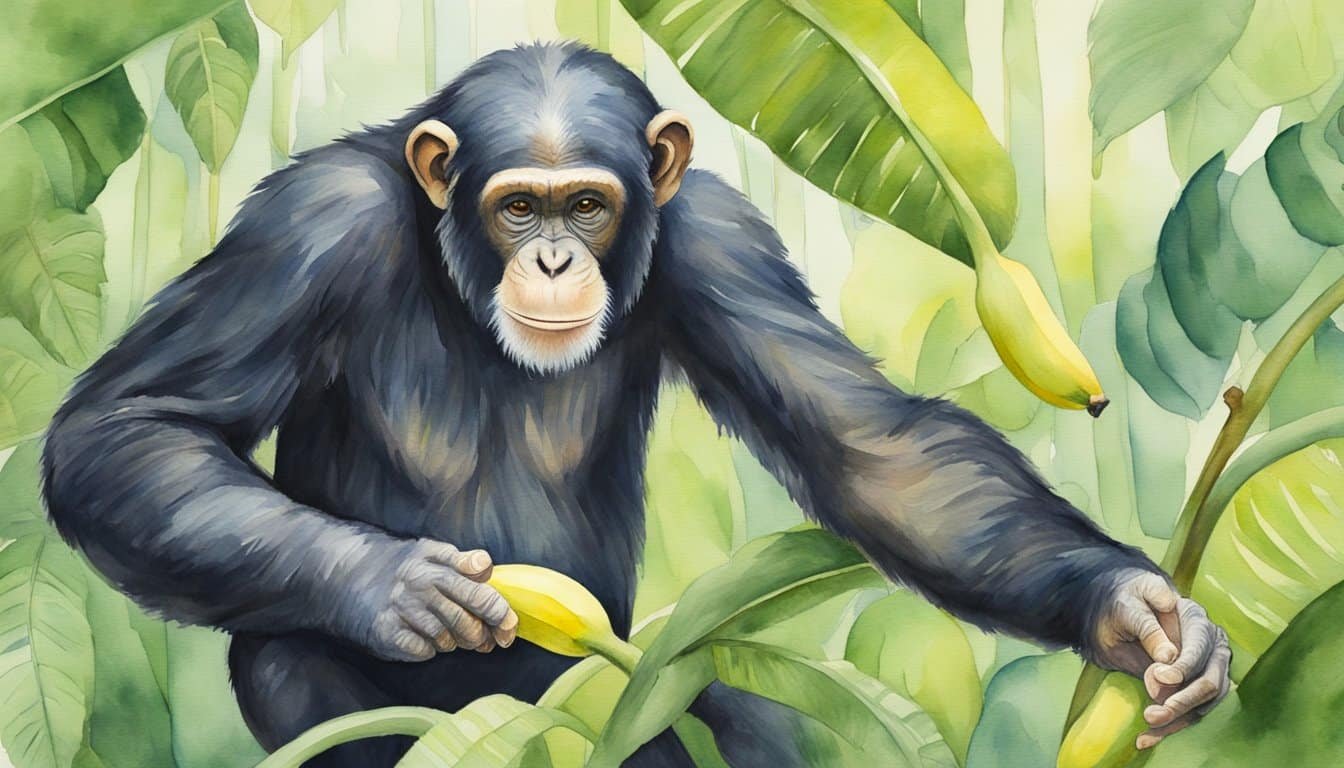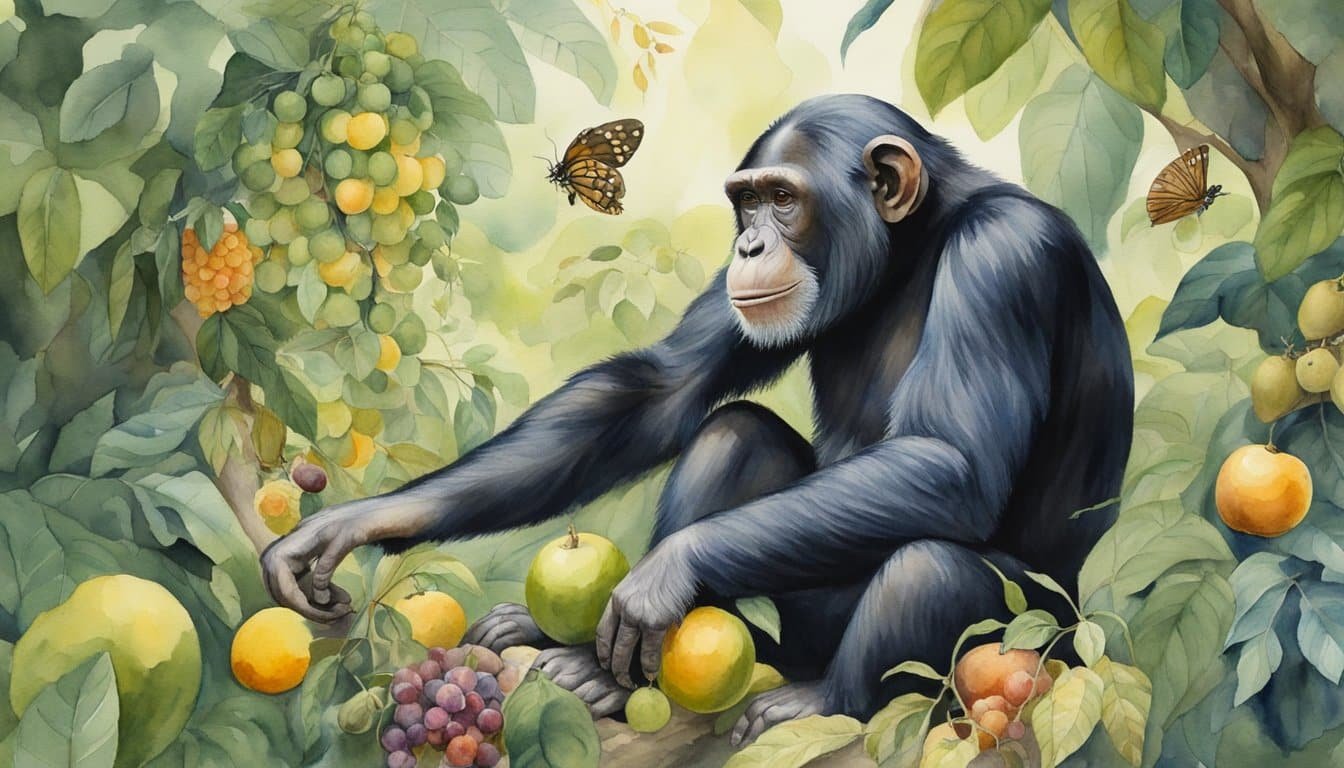Chimpanzee Feeding Habits
Chimpanzees are known for their varied and complex diet, which can consist of over 300 different food items. Their foraging habits have adapted to the diverse habitats they inhabit, from the wet rainforests to the dry savannas.
Fruit Consumption
Chimpanzees have a great fondness for fruits, which constitute a major portion of their diet. They are particularly keen on figs, which provide them with sugars and fiber. When fruits are abundant, they can make up about 50-90% of a chimpanzee’s diet, which varies from one community to another. For instance, they enjoy the diversity found in the Gombe National Park, demonstrating eclectic preferences that range from the sweetest fruits to the more fibrous varieties.
Leaf and Plant Diet
In addition to fruit, leaves also play a critical role in the diet of chimpanzees. They consume a wide array of leaves, along with flowers, nuts, and seeds. While not as calorically dense as fruits, these plant parts are important sources of protein, vitamins, and minerals. Moreover, leaves serve as a reliable food source during seasons when fruits are scarce, showcasing the species’ adaptability.
Insect and Meat Intake
Despite their largely vegetarian diet, chimpanzees also incorporate insects and meat into their meals. They skillfully hunt small mammals, including colobus monkeys, and are quite adept at termite fishing—extracting termites from their mounds using sticks. Such meat and insects are valuable protein sources, though they typically make up a minor portion of the overall diet. The practice of hunting also has significant social implications within chimpanzee groups.
Chimpanzee Food Acquisition

Chimpanzees have a varied diet and their methods of obtaining food are intricately adapted to their environment. From using tools to harvest termites to strategic hunting techniques, these primates exhibit a remarkable level of sophistication in their feeding strategies.
Use of Tools
Chimpanzees are well-known for their tool use, particularly when it involves getting their hands on insects or honey. For example, they fashion sticks into probes to extract termites or ants from their nests or to dip into beehives for honey. Stones can also serve as nutcrackers, allowing them access to the nutritious seeds encased within hard shells.
Foraging Techniques
When it comes to foraging, chimpanzees employ a variety of techniques. They might spend a significant amount of time moving through the trees in search of fruits, often their preferred food source. Chimpanzees also forage on the ground where they may uncover roots or select specific leaves and stems as part of their diet.
Hunting Behavior and Strategy
Chimpanzee hunting involves both strategy and cooperation. They may work in teams to corner monkeys or small mammals, showing a level of planning and coordination. This kind of behavior is not just about sustenance but also plays a role in social bonding and establishing hierarchies within the group.
Dietary Impact on Social and Physical Health

Chimpanzee diets play a crucial role in their social interactions and physical well-being. Proper nutrition is essential for energy, disease prevention, and successful reproduction within their communities.
Nutritional Requirements and Health
Chimpanzees in Africa’s forests are omnivores, and their diet is instrumental in maintaining their health. Infants rely on their mother’s milk for survival, which provides them with all the necessary nutrients for growth. As they wean, their diet shifts to include a variety of plant and animal sources. Sufficient energy intake is vital for infant chimpanzees to thrive and for the mother to support reproduction. Diseases are less prevalent when a proper diet is observed, showcasing the direct link between nutrition and health.
Social Structures and Feeding
Diet significantly influences social interactions among chimpanzees. Their feeding habits, such as sharing meat or grooming one another after group hunts, help to establish and maintain complex social bonds. The quest for food is a social event and can often determine the hierarchy within the group. A study on antioxidant content in diet suggests that rapid dietary changes also affect the oxidative status of chimpanzees, which can influence social dynamics.
Diet Similarities with Humans
Observations by Jane Goodall and other primatologists have shown remarkable similarities between human and chimpanzee diets. Both species are flexible eaters that include a wide range of foods for nutritional balance, which is uncommon in other animals. The ability to adapt their diet based on availability impacts survival and is a trait they share with their human cousins. The evolution of diet among chimpanzees and human foragers highlights the importance of dietary choices in the development of intellect and societal structures.

